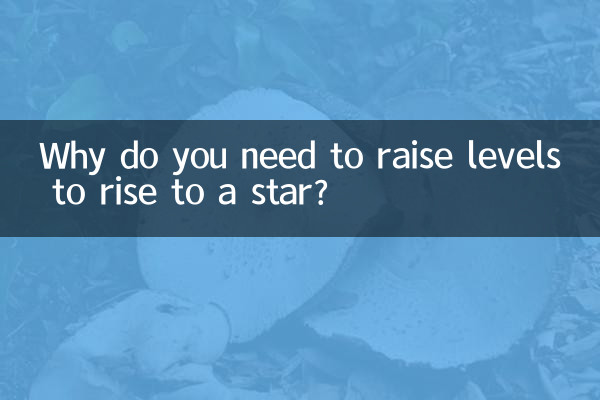Why do you need to raise levels to rise to a star?
In various development games, "star promotion" and "level development" are the core means for players to improve the strength of their characters or equipment. However, many novice players often ignore the importance of "leveling up" and directly pursue star promotion, resulting in a waste of resources or substandard character strength. This article will combine the hot topics and hot content on the Internet in the past 10 days, analyze the relationship between rising stars and raising levels, and display relevant data in a structured way to help players grow efficiently.
1. The relationship between star promotion and level raising

Star promotion usually refers to improving the star rating of a character or equipment by consuming specific materials or repeating character fragments, and unlocking higher attribute caps or skill effects. Leveling up is to improve basic attributes through experience accumulation or resource investment. The relationship between the two is as follows:
| project | rising star | Feeding level |
|---|---|---|
| core role | Unlock upper limit and strengthen skills | Basic attribute improvement |
| Resource consumption | Fragments/exclusive materials | General experience/gold coins |
| priority | High returns later | Essential in the early stage |
2. Typical cases in popular games on the Internet
According to the recent discussion among players, the following games have attracted widespread attention due to their "star promotion and level raising" mechanism:
| Game name | Popular controversial points | Player suggestions |
|---|---|---|
| "Original God" | Character breakthrough requires reaching the required level | Prioritize upgrading to level 80 and then upgrade to stars |
| "Honkai Impact: Star Rail" | Light cone enhancement consumes a lot of money | Balanced distribution of experience materials |
| "Phantom Tower" | Weapon attributes do not match after upgrading | Simultaneously upgrade weapon levels |
3. Core advantages of raising levels
1.Maximize resource efficiency: High-level characters can directly enjoy attribute bonuses when they upgrade to stars, to avoid falsely inflating combat power due to low base levels after star upgrades.
2.Copy threshold met: Most dungeons require the character level to reach the standard, and raising the level can quickly unlock the gameplay.
3.smooth transition period: The acquisition cycle of star-increasing materials is long, and the level can be maintained to grow steadily.
4. Comparison of actual measurement data of players across the entire network
The following are the test results of different training paths for the same character by players on a popular forum (full star is 5 stars):
| Training method | Combat rating | Resource consumption |
|---|---|---|
| Directly upgrade to 5 stars (level 50) | 6500 | Fragments×200 |
| Raise to level 80 first (3 stars) | 7200 | Experience book×120 |
| Synchronous development (4 stars + level 70) | 8100 | Fragments × 100 + Experience Book × 80 |
5. Summary and suggestions
1.Novice period: Mainly focus on leveling up, at least upgrade the main character to the recommended level of the current version (such as level 80).
2.medium term planning: Star promotion and level raising are carried out simultaneously, and priority is given to ensuring that key skills are unlocked.
3.Resource allocation: Daily mission experience must be gained, and star promotion materials are reserved according to the activity cycle.
Through structural analysis, it can be seen that raising levels is the basic support for rising stars. Only by properly planning the rhythm of the two can a qualitative change in character intensity be achieved. In recent popular games, more and more players have called for "laying a solid foundation first, and then pursuing stars", and this strategy has gradually become a mainstream consensus.

check the details

check the details